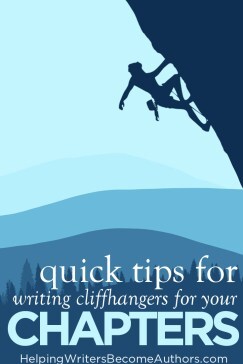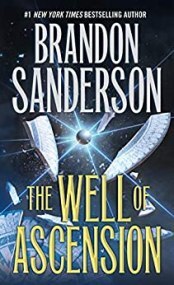How to Use Chapter Cliffhangers in Your Fiction
 Note: I’m taking a two-week break from the usual post and podcast, so am sharing this shortie instead. Enjoy!
Note: I’m taking a two-week break from the usual post and podcast, so am sharing this shortie instead. Enjoy!
We all want to write stories that keep readers turning pages into the wee hours of the morning. We want readers to reach the end of a chapter and be gripped with an undeniable need to keep reading. We want to them take a look at the clock and promise themselves, Just one more chapter—and then have that “one more” morph into half the book.
We’ve all read books like this. So what’s the secret to writing one?
In a word: chapter cliffhangers.
How you craft the closing paragraph of your chapters has a huge effect on whether or not readers will decide to read “one more chapter”—or stick their bookmarks between the pages and leave your characters in limbo until tomorrow night. You must give them a reason to keep reading: a question that must be answered, a character that must be saved from a dire predicament, or a surge of forward motion in the plot progression.

The Well of Ascension by Brandon Sanderson (affiliate link)
Fantasy powerhouse Brandon Sanderson did this admirably in The Well of Ascension, the second book in his beloved Mistborn series (and, really, all his books). This heavyweight 800-page novel reads more like a fast 350 pages thanks, in large part, to chapter breaks that don’t feel like breaks at all… they’re more like accelerators.
Sanderson ends every one of his chapters with a hook that draws readers directly into the next chapter. He never ties off all the loose ends, and he always gives a hint of something exciting, intriguing, or unexpected around the corner in the subsequent scene.
Although some of his chapters do indeed end with the characters in mortal danger (in essence, hanging off a cliff), he understands this extremism isn’t always necessary and that, indeed, it would grow monotonous and begin to feel gimmicky to readers if overused.
For example, the first chapter ends with this in medias res action beat:
At that moment, a burst of coins shot through the mists, spraying toward Vin.
But Chapter 4 teases readers with a subtler hook:
“Come,” Sazed said, turning toward the village. “There are other things—more practical things—that I can teach you.”
To achieve the same effect in your own fiction, follow his example of masterfully varying the intensity of the hooks, while always promising readers something worthwhile in the next chapter—and then fulfilling that promise.
Wordplayers, tell me your opinions! How have you used chapter cliffhangers on your fiction? Tell me in the comments!___
Love Helping Writers Become Authors? You can now become a patron. (Huge thanks to those of you who are already part of my Patreon family!)The post How to Use Chapter Cliffhangers in Your Fiction appeared first on Helping Writers Become Authors.




